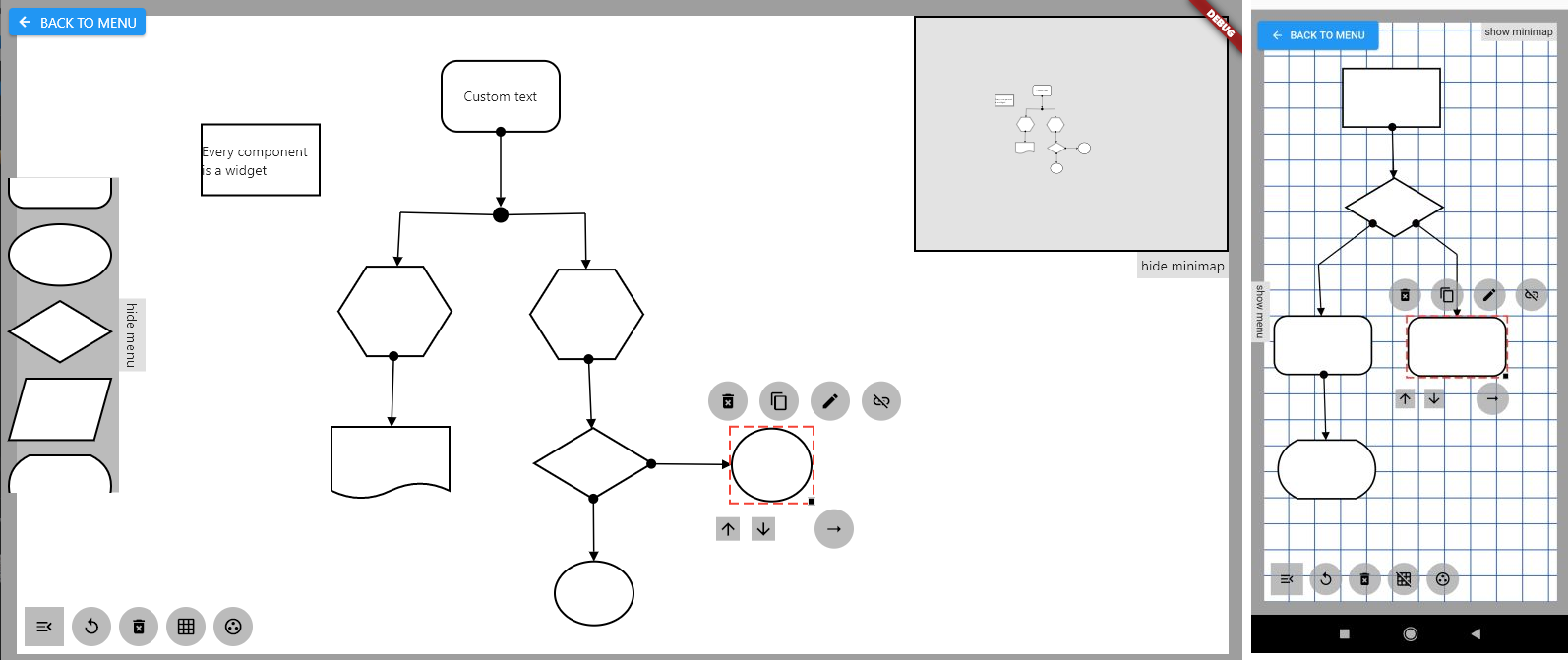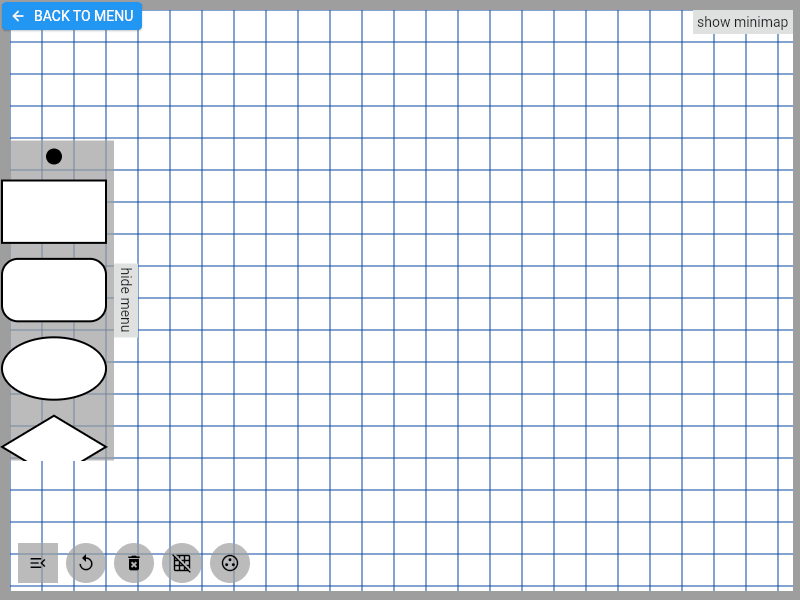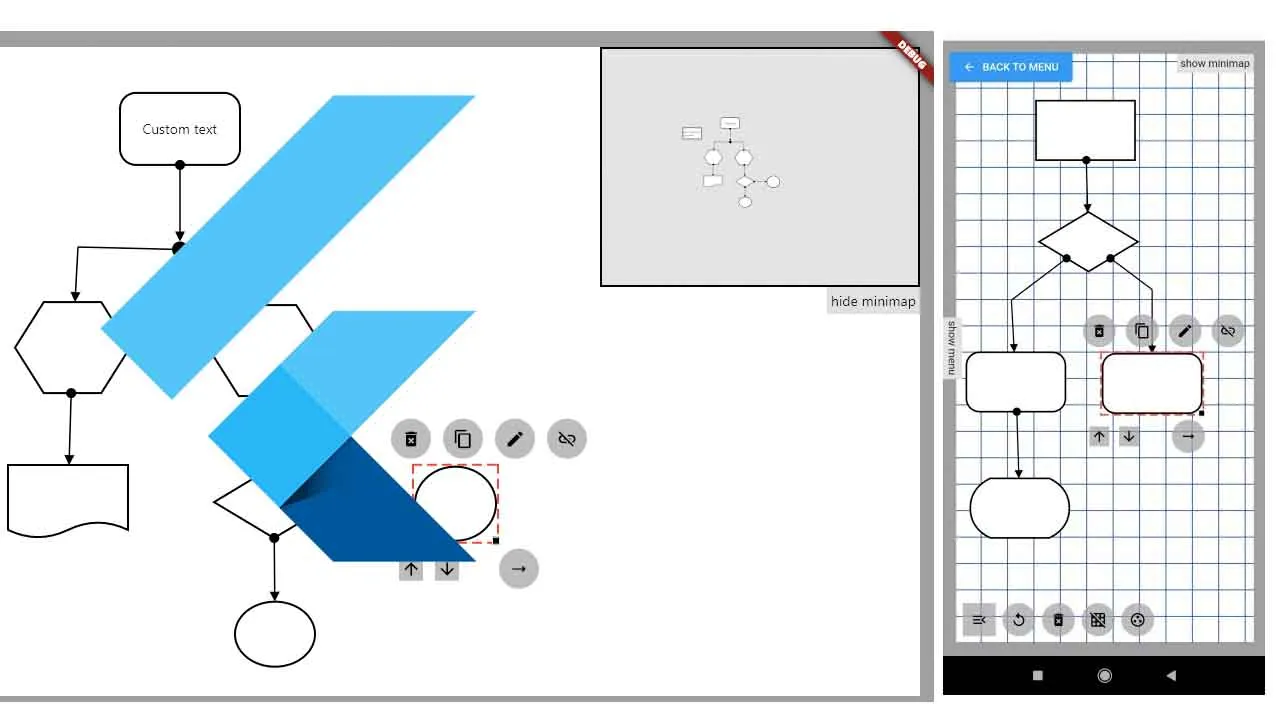A Flutter Shape Editor Library That Provides DiagramEditor Widget
shape_editor
Flutter diagram editor library for showing and editing diagrams of custom type. It provides DiagramEditor widget and a possibility to customize all editor design and behavior.

Demo App Example (example source code)
Getting Started
Use of DiagramEditor widget:
DiagramEditor(
diagramEditorContext: DiagramEditorContext(
policySet: myPolicySet,
),
),
myPolicySet is a class composed of mixins, for example:
class MyPolicySet extends PolicySet
with
MyInitPolicy,
CanvasControlPolicy,
LinkControlPolicy,
LinkJointControlPolicy,
LinkAttachmentRectPolicy {}
MyInitpolicy can be following:
mixin MyInitPolicy implements InitPolicy {
@override
initializeDiagramEditor() {
canvasWriter.state.setCanvasColor(Colors.grey);
}
}
For example in MyCanvasPolicy in function onCanvasTapUp(TapUpDetails details) a new component is added if no component is selected.
mixin MyCanvasPolicy implements CanvasPolicy, CustomPolicy {
@override
onCanvasTapUp(TapUpDetails details) async {
canvasWriter.model.hideAllLinkJoints();
if (selectedComponentId != null) {
hideComponentHighlight(selectedComponentId);
} else {
canvasWriter.model.addComponent(
ComponentData(
size: Size(96, 72),
position: canvasReader.state.fromCanvasCoordinates(details.localPosition),
data: MyComponentData(),
),
);
}
}
}
There are several editor policies that can be implemented and added to the policy set:
InitPolicyCanvasPolicyComponentPolicyComponentDesignPolicyLinkPolicyLinkJointPolicyLinkAttachmentPolicyLinkWidgetsPolicyCanvasWidgetsPolicyComponentWidgetsPolicy
Some policies are already implemented and ready to use:
CanvasControlPolicyLinkControlPolicyLinkJointControlPolicyLinkAttachmentRectPolicy
Possibilities of usage of individual policies are described in the documentation. More in examples (links above).

Use this package as a library
Depend on it
Run this command:
With Flutter:
$ flutter pub add shape_editorThis will add a line like this to your package's pubspec.yaml (and run an implicit flutter pub get):
dependencies:
shape_editor: ^0.0.1Alternatively, your editor might support flutter pub get. Check the docs for your editor to learn more.
Import it
Now in your Dart code, you can use:
import 'package:shape_editor/diagram_editor.dart'; import 'dart:math' as math;
import 'package:shape_editor/diagram_editor.dart';
import 'package:flutter/material.dart';
void main() => runApp(const DiagramApp());
class DiagramApp extends StatefulWidget {
const DiagramApp({Key? key}) : super(key: key);
@override
_DiagramAppState createState() => _DiagramAppState();
}
class _DiagramAppState extends State<DiagramApp> {
MyPolicySet myPolicySet = MyPolicySet();
@override
Widget build(BuildContext context) {
return MaterialApp(
home: Scaffold(
body: SafeArea(
child: Stack(
children: [
Container(color: Colors.grey),
Padding(
padding: const EdgeInsets.all(16),
child: DiagramEditor(
diagramEditorContext:
DiagramEditorContext(policySet: myPolicySet),
),
),
Padding(
padding: const EdgeInsets.all(0),
child: Row(
children: [
ElevatedButton(
onPressed: () => myPolicySet.deleteAllComponents(),
style: ElevatedButton.styleFrom(primary: Colors.red),
child: const Text('delete all')),
const Spacer(),
ElevatedButton(
onPressed: () => myPolicySet.serialize(),
child: const Text('serialize')),
const SizedBox(width: 8),
ElevatedButton(
onPressed: () => myPolicySet.deserialize(),
child: const Text('deserialize')),
],
),
),
],
),
),
),
);
}
}
// Custom component Data which you can assign to a component to dynamic data property.
class MyComponentData {
MyComponentData();
bool isHighlightVisible = false;
Color color =
Color((math.Random().nextDouble() * 0xFFFFFF).toInt()).withOpacity(1.0);
showHighlight() {
isHighlightVisible = true;
}
hideHighlight() {
isHighlightVisible = false;
}
// Function used to deserialize the diagram. Must be passed to `canvasWriter.model.deserializeDiagram` for proper deserialization.
MyComponentData.fromJson(Map<String, dynamic> json)
: isHighlightVisible = json['highlight'],
color = Color(int.parse(json['color'], radix: 16));
// Function used to serialization of the diagram. E.g. to save to a file.
Map<String, dynamic> toJson() => {
'highlight': isHighlightVisible,
'color': color.toString().split('(0x')[1].split(')')[0],
};
}
// A set of policies compound of mixins. There are some custom policy implementations and some policies defined by diagram_editor library.
class MyPolicySet extends PolicySet
with
MyInitPolicy,
MyComponentDesignPolicy,
MyCanvasPolicy,
MyComponentPolicy,
CustomPolicy,
//
LinkControlPolicy,
LinkJointControlPolicy,
LinkAttachmentRectPolicy {}
// A place where you can init the canvas or your diagram (eg. load an existing diagram).
mixin MyInitPolicy implements InitPolicy {
@override
initializeDiagramEditor() {
canvasWriter.state.setCanvasColor(Colors.grey[300]!);
}
}
// This is the place where you can design a component.
// Use switch on componentData.type or componentData.data to define different component designs.
mixin MyComponentDesignPolicy implements ComponentDesignPolicy {
@override
Widget showComponentBody(ComponentData componentData, double scale) {
return Container(
decoration: BoxDecoration(
color: (componentData.data as MyComponentData).color,
border: Border.all(
width: 2,
color: (componentData.data as MyComponentData).isHighlightVisible
? Colors.pink
: Colors.black,
),
),
child: const Center(child: Text('component')),
);
}
}
// You can override the behavior of any gesture on canvas here.
// Note that it also implements CustomPolicy where own variables and functions can be defined and used here.
mixin MyCanvasPolicy implements CanvasPolicy, CustomPolicy {
@override
onCanvasTapUp(TapUpDetails details) {
canvasWriter.model.hideAllLinkJoints();
if (selectedComponentId != null) {
hideComponentHighlight(selectedComponentId);
} else {
canvasWriter.model.addComponent(
ComponentData(
size: const Size(96, 72),
position:
canvasReader.state.fromCanvasCoordinates(details.localPosition),
data: MyComponentData(),
),
);
}
}
}
// Mixin where component behaviour is defined. In this example it is the movement, highlight and connecting two components.
mixin MyComponentPolicy implements ComponentPolicy, CustomPolicy {
// variable used to calculate delta offset to move the component.
late Offset lastFocalPoint;
@override
onComponentTap(String componentId) {
canvasWriter.model.hideAllLinkJoints();
bool connected = connectComponents(selectedComponentId, componentId);
hideComponentHighlight(selectedComponentId);
if (!connected) {
highlightComponent(componentId);
}
}
@override
onComponentLongPress(String componentId) {
hideComponentHighlight(selectedComponentId);
canvasWriter.model.hideAllLinkJoints();
canvasWriter.model.removeComponent(componentId);
}
@override
onComponentScaleStart(componentId, details) {
lastFocalPoint = details.localFocalPoint;
}
@override
onComponentScaleUpdate(componentId, details) {
Offset positionDelta = details.localFocalPoint - lastFocalPoint;
canvasWriter.model.moveComponent(componentId, positionDelta);
lastFocalPoint = details.localFocalPoint;
}
// This function tests if it's possible to connect the components and if yes, connects them
bool connectComponents(String? sourceComponentId, String? targetComponentId) {
if (sourceComponentId == null || targetComponentId == null) {
return false;
}
// tests if the ids are not same (the same component)
if (sourceComponentId == targetComponentId) {
return false;
}
// tests if the connection between two components already exists (one way)
if (canvasReader.model.getComponent(sourceComponentId).connections.any(
(connection) =>
(connection is ConnectionOut) &&
(connection.otherComponentId == targetComponentId))) {
return false;
}
// This connects two components (creates a link between), you can define the design of the link with LinkStyle.
canvasWriter.model.connectTwoComponents(
sourceComponentId: sourceComponentId,
targetComponentId: targetComponentId,
linkStyle: LinkStyle(
arrowType: ArrowType.pointedArrow,
lineWidth: 1.5,
backArrowType: ArrowType.centerCircle,
),
);
return true;
}
}
// You can create your own Policy to define own variables and functions with canvasReader and canvasWriter.
mixin CustomPolicy implements PolicySet {
String? selectedComponentId;
String serializedDiagram = '{"components": [], "links": []}';
highlightComponent(String componentId) {
canvasReader.model.getComponent(componentId).data.showHighlight();
canvasReader.model.getComponent(componentId).updateComponent();
selectedComponentId = componentId;
}
hideComponentHighlight(String? componentId) {
if (componentId != null) {
canvasReader.model.getComponent(componentId).data.hideHighlight();
canvasReader.model.getComponent(componentId).updateComponent();
selectedComponentId = null;
}
}
deleteAllComponents() {
selectedComponentId = null;
canvasWriter.model.removeAllComponents();
}
// Save the diagram to String in json format.
serialize() {
serializedDiagram = canvasReader.model.serializeDiagram();
}
// Load the diagram from json format. Do it cautiously, to prevent unstable state remove the previous diagram (id collision can happen).
deserialize() {
canvasWriter.model.removeAllComponents();
canvasWriter.model.deserializeDiagram(
serializedDiagram,
decodeCustomComponentData: (json) => MyComponentData.fromJson(json),
decodeCustomLinkData: null,
);
}
} Download details:
Author: NicolasCiviero
Source: https://github.com/NicolasCiviero/flutter_diagram_editor
